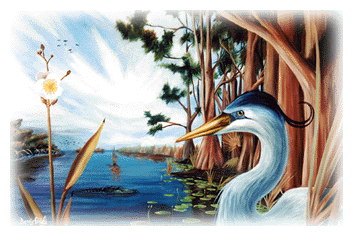
Wetlands Program
The Wetlands Program is managed by the Aquatic and Wetlands Resources Section. The mission of the section is to protect, restore and enhance the biological productivity, abundance and diversity of marine, estuarine, freshwater and terrestrial resources, which includes Broward County’s wetland resources.
What is a Wetland?
Wetlands are areas of transition between land and water. In general, a wetland is an ecosystem where water is at or covering the surface of the ground for all or part of the year; in Florida, wetlands may be defined by looking at the types of plants growing in them, by the types of soils present and/or the presence of hydrologic (water level) indicators.
The Value of Wetlands
One of the world’s most important natural resources and are the most productive ecosystems in the world.
Improving Water Quality
Wetlands serve as Natural Filtration Systems
Protecting from Floods
Wetlands provide storage areas that provide flood protection
Controlling Shoreline Erosion
The plants found in wetlands retain excess nutrients and some pollutants and physically hold soil in place with their root systems, reducing and absorbing wave energy and erosion.
Recharging Florida's Aquifer
Wetlands serve as important aquifer recharge areas or areas where groundwater is replenished.
Recreation and Appreciation
Wetlands have recreational, historical, scientific and cultural values. They provide places to hunt, fish, canoe, boat, bird watch and photograph wildlife, and they provide natural scenic vistas for nature lovers and artists.
Biological
Wetlands provide food that attract many animal species. Dead plant leaves and stems break down in the water to form small particles of “detritus” or enriched organic material. This detritus feeds many small aquatic insects, shellfish and small fish that are food for larger predatory fish, reptiles, amphibians, birds and mammals.
Many of the U.S. breeding bird populations including ducks, geese, hawks, woodpeckers, wading birds and many songbirds feed, nest and raise their young in wetlands. Fish use inland and coastal wetland areas for spawning and nursery areas.
Wetlands have been compared to tropical rain forests and coral reefs in the number and diversity of animal and plant species they support. In fact, more than one-third of the United States’ threatened and endangered species live only in wetlands and nearly half use wetlands at some point in their lives. In addition to the habitat wetlands provide, they also provide important water quality benefits.
Human Impacts on Wetlands
South Florida’s wetlands have also suffered secondary impacts from human development pressures. The alteration of Southeast Florida’s hydrology by the elaborate canal systems designed to protect residents from flooding has impacted wetlands by decreasing the hydrology necessary for maintaining wetland plant species. Pollutants from storm runoff on streets and highways combined with the use of fertilizers and pesticides have increased the nutrients introduced into surface waters and degraded the water quality that supports wetland plant species. Another impact has been the introduction of non-native plant species also known as exotics. Two well-known exotics, the Melaleuca and Brazilian pepper trees, have overgrown wetland areas. Their rapid growth chokes out native species and decreases the habitat value of the wetlands.
